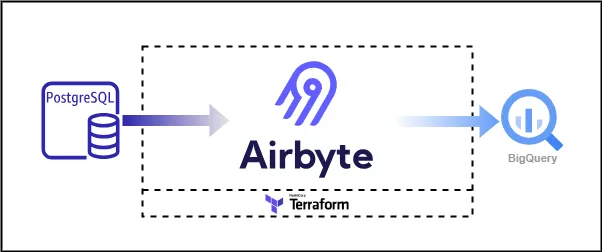New: Check out the Airbyte 2.0 release
Build a Low-Latency Data Availability solution that syncs data from an existing Postgres database to a BigQuery dataset using Airbyte, using Change Data Capture (CDC) and Postgres Write Ahead Log (WAL).
Summarize this article with:
Welcome to the "Low-Latency Data Availability Stack" repository! This repo provides a quickstart template for building a Low-Latency Data Availability solution that syncs data from an existing Postgres database to a BigQuery dataset using Airbyte. We will easily replicate the tables and data from the Postgres database to BigQuery with Airbyte using Change Data Capture (CDC) and Postgres Write Ahead Log (WAL). This quickstart also explores using Airbyte Postgres features to ensure near real-time data availability and access. While this template doesn't delve into specific data, its goal is to showcase how the low latency data solution can be achieved with Airbyte.
Just like other Airbyte quickstarts, this quickstart is designed to minimize setup hassles and propel you forward.

Before you embark on this integration, ensure you have the following set up and ready:
Get the project up and running on your local machine by following these steps:
1. Clone the repository (Clone only this quickstart):
2. Navigate to the directory:
3. Set Up a Virtual Environment:
• For Mac:
• For Windows:
4. Install Dependencies:
Airbyte allows you to create connectors for sources and destinations, facilitating data synchronization between various platforms. In this project, we're harnessing the power of Terraform to automate the creation of these connectors and the connections between them. Here's how you can set this up:
1. Navigate to the Airbyte Configuration Directory:
Change to the relevant directory containing the Terraform configuration for Airbyte:
2. Modify Configuration Files:
Within the infra/airbyte directory, you'll find three crucial Terraform files:
• provider.tf: Defines the Airbyte provider.
• main.tf: Contains the main configuration for creating Airbyte resources.
• variables.tf: Holds various variables, including credentials.
Adjust the configurations in these files to suit your project's needs. Specifically, provide credentials for your Postgres and BigQuery connections. You can utilize the variables.tf file to manage these credentials.
3. Initialize Terraform:
This step prepares Terraform to create the resources defined in your configuration files
4. Review the Plan:
Before applying any changes, review the plan to understand what Terraform will do.
5. Apply Configuration:
After reviewing and confirming the plan, apply the Terraform configurations to create the necessary Airbyte resources.
6. Verify in Airbyte UI:
Once Terraform completes its tasks, navigate to the Airbyte UI. Here, you should see your Postgres source and BigQuery destination connectors, as well as the connection between them, set up and ready to go.
Using Airbyte for the data replication offers the following for achieving low latency;
Once you've set up and launched this initial integration, you can proceed to sync the connection to trigger the data sync. The real power of this quickstart lies in its adaptability and extensibility. Here’s a roadmap to help you customize and harness this project tailored to your specific data needs:
Download our free guide and discover the best approach for your needs, whether it's building your ELT solution in-house or opting for Airbyte Open Source or Airbyte Cloud.
